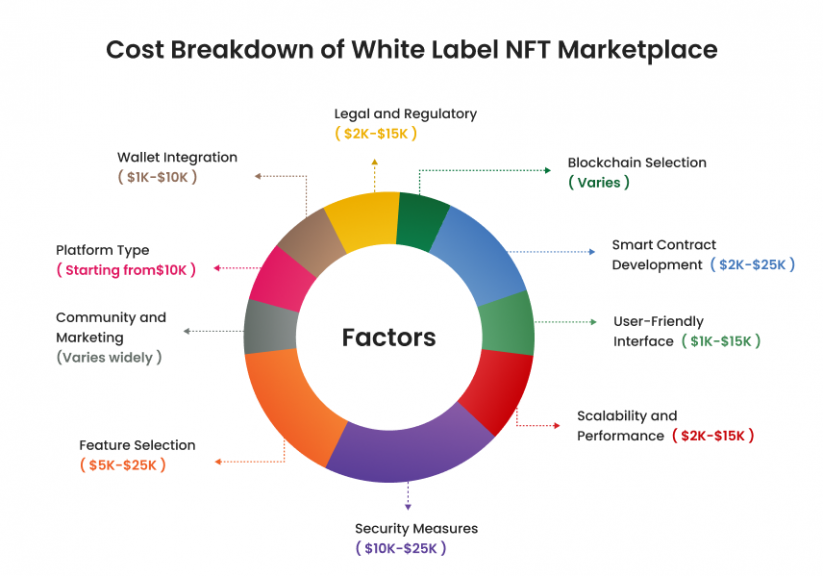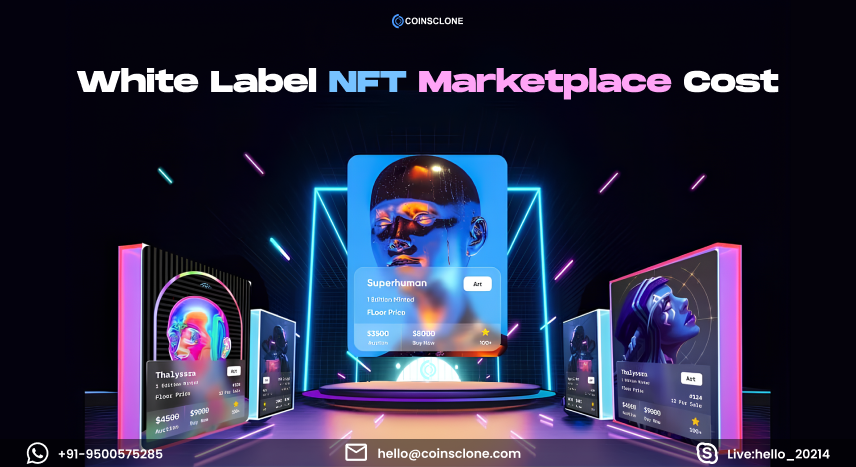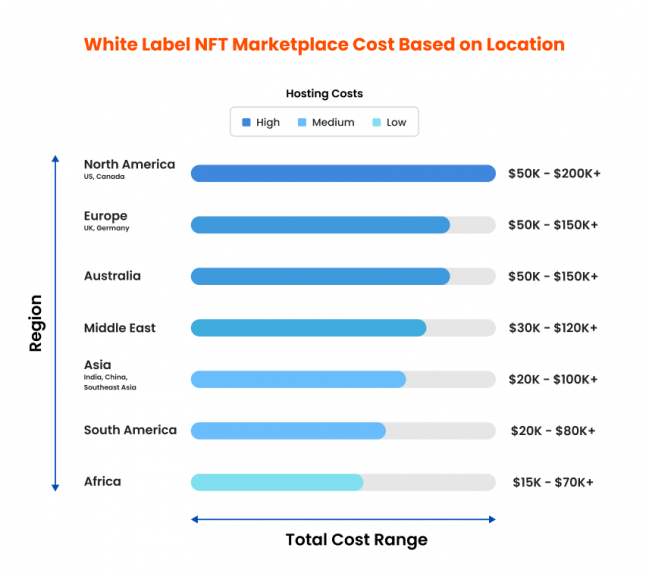The concept of a White Label NFT Marketplace represents a strategic approach for businesses seeking to enter the rapidly expanding world of digital assets. These platforms offer a customizable solution that minimizes upfront development costs while maximizing efficiency and scalability.
Creating a White Label NFT Platform offers a lucrative opportunity. If you want to create your own NFT Marketplace, you need to consider the cost. And also there are various factors that influence the development costs. Understanding the factors that affect the cost is crucial for startups looking to capitalize on the burgeoning NFT market.
This article delves into a detailed breakdown of the Cost of this White Label software factors, providing insights into how businesses can navigate these complexities to build a successful NFT Marketplace that meets both operational goals and market demands.
Reason Why this Readymade NFT Marketplace Solution is Affordable
A White Label NFT Marketplace Software refers to a customizable platform that can be branded and tailored to suit the specific needs of a business or individual without having to build it from scratch. It offers a ready-made infrastructure that can be quickly deployed with minimal development effort, allowing users to focus on branding, marketing, and user engagement rather than infrastructure development. Let us see the major reasons that make White-label software a cost-effective solution in two categories.
Cost-Effectiveness at its Core
-
Reduced Development Time and Costs
Building a custom NFT Marketplace from the ground up can be a time-consuming and resource-intensive process. Businesses can significantly reduce development time and costs by opting for a white-label solution. The core functionalities such as NFT minting, buying, selling, and trading are already integrated into the platform, cutting down on development hours and associated costs.
-
Scalability and Flexibility
These solutions are designed to be scalable, allowing businesses to expand their operations seamlessly as their user base grows. Whether it’s handling increased transactions or adding new features, these platforms are built to accommodate growth without requiring extensive redevelopment efforts. This scalability ensures that businesses can adapt to market demands swiftly and effectively.
-
Lower Operational Overheads
Maintaining and updating a custom-built NFT Marketplace can be a continuous financial burden, requiring dedicated resources for maintenance, security, and upgrades. White-label solutions often include ongoing support and updates as part of their service, reducing the operational overheads associated with running a digital marketplace.
Strategic Advantages
-
Focus on Branding and User Experience
With this Tailor-made NFT Platform, businesses can prioritize branding and user experience enhancements rather than backend development. Customizable themes, UI/UX design options, and branding elements allow for a personalized customer journey, enhancing engagement and loyalty among users.
-
Access to Expertise
This solution providers often bring expertise and industry knowledge to the table, offering insights into market trends, regulatory compliance, and best practices. This expertise can be invaluable, especially for businesses new to the NFT ecosystem, ensuring they navigate complexities effectively.
-
Quick Time-to-Market
In a competitive crypto world, quickly time to market is crucial. This ready-to-launch solutions enable businesses to launch their NFT Marketplace swiftly, capitalizing on market opportunities without prolonged development cycles. This agility can be a significant competitive advantage in a rapidly evolving digital landscape.
Detailed Breakdown of Cost of White-Label NFT Software
For Startups like you, knowing the exact cost will help you decide your budget and time constraints before diving into a startup project. So, the overall cost to set up this readymade NFT Marketplace solution can vary significantly based on customization, scale, and specific requirements. A rough estimate would range from $25,000 to $1,50,000. This estimate accounts for the development of essential components such as blockchain integration, smart contracts, user interfaces, security measures, marketing efforts, legal compliance, and ongoing operational costs. Here, we delve into the key factors affecting the cost of White-Label NFT Software.

Blockchain selection
The choice of blockchain significantly impacts the cost of this turnkey NFT Marketplace software. Different blockchains like Ethereum, Binance Smart Chain, and others have varying transaction fees and costs associated with smart contract deployment.
Each blockchain also comes with its own set of development tools and languages, requiring specific expertise to integrate smoothly. The ecosystem support, including developer tools, community backing, and infrastructure readiness, further influences development efficiency and ongoing maintenance costs.
Also Read : Choose the Right Blockchain to Create NFT Marketplace
Smart Contract development
Developing and deploying smart contract is a critical aspect of this readymade NFT Marketplace cost. Customizing these smart contracts to meet specific business requirements involves careful planning and coding.
Moreover, ensuring these contracts are audited for security vulnerabilities and compliance adds to the development costs. However, it is essential to maintain trust and reliability within the marketplace.
User-friendly Interface
The design and functionality of the user interface (UI) and user experience (UX) play a crucial role in attracting and retaining users. Creating a user-friendly interface that makes it easy for people to create, buy, and sell NFTs can increase user engagement.
However, it can be expensive, especially when customizations or advanced interactive features are needed. Tailoring the UI to align with branding and user preferences further increases the costs, as it demands meticulous design and implementation.
Scalability and Performance
Anticipating and accommodating future growth in terms of user base and transaction volume is essential for scalability. It’s important to plan your infrastructure carefully to handle increased demand without losing performance.
This may involve investing in decentralized storage solutions or layer 2 scaling technologies. These scalability measures incur additional development costs but are crucial for ensuring smooth and efficient marketplace operations.
Feature Selection
The complexity and scope of features offered by the marketplace significantly impact development costs. Features such as auctions, bidding mechanisms, instant purchases, NFT bundling, and secondary marketplace functionalities require careful integration and customization. Each additional feature increases development complexity and may necessitate more extensive testing and refinement, thereby adding to overall development expenses.
Also Read : Essential Features of NFT Marketplace
Security Measures
Ensuring robust security measures is paramount to protect user data, NFT assets, and the overall integrity of the NFT Marketplace. Implementing encryption, secure authentication mechanisms, and rigorous protocols to prevent unauthorized access and vulnerabilities requires dedicated development effort and ongoing maintenance. Regular security audits and compliance with industry standards are essential to maintaining a secure environment.
Community and Marketing
Building a vibrant user community and effectively marketing the marketplace is crucial for its success. Allocating resources for community management, engagement campaigns, and user acquisition strategies involves budgeting for promotional activities and partnerships. Influencer collaborations may also be considered as part of the strategy. These marketing efforts are essential for increasing marketplace visibility, attracting users, and fostering a thriving ecosystem but require a financial investment.
Platform Type
Choosing the platform type affects development costs and user accessibility. The platform you want to create can be a web-based, mobile app, or both. Developing a platform that is compatible across different devices and operating systems requires additional development effort and testing. Each platform type comes with its development challenges and costs, influencing the overall budget and timeline for marketplace deployment.
Wallet Integration
Integrating with various cryptocurrency wallets to facilitate seamless transactions and NFT management is crucial for user convenience and adoption. Ensuring compatibility with popular wallets and implementing secure wallet integration protocols to safeguard user assets adds to development costs. The complexity of integrating and maintaining these wallet functionalities within the NFT Marketplace infrastructure requires ongoing investment in development and security measures.
Legal and Regulatory Compliance
Adhering to legal and regulatory requirements is essential for operating a compliant marketplace. Understanding and navigating the complex landscape of regulations concerning NFTs, cryptocurrencies, financial transactions, and data privacy requires legal expertise and ongoing compliance efforts. Engaging legal counsel to ensure the marketplace operates within legal boundaries and meets regulatory obligations adds to marketplace establishment and maintenance costs.
By carefully considering and addressing these detailed factors, startups can better estimate and manage the cost of this tailormade white-label NFT Software. Each factor contributes to the overall complexity and expense of building a successful marketplace that meets both technical requirements and regulatory standards while delivering a positive user experience.
Now let us see the…
Geo-Based Estimate of Turnkey White-Label NFT Solution
The cost of this turnkey NFT Marketplace Software can vary significantly based on geography. Also, due to differences in labor costs, regulatory requirements, and market conditions. Here’s a general comparison based on different regions:
North America
In North America, which includes the United States and Canada, development costs are typically higher due to elevated wages for developers and designers. The regulatory environment is generally well-defined but can be intricate, sometimes necessitating legal consultation. Hosting costs are moderately high. Overall project costs can vary significantly, ranging from $50,000 to $200,000 or more, depending on the extent of customization and features required.
Europe
In Europe, encompassing countries like the United Kingdom and Germany, development costs are similar to North America, with moderately high wages. The regulatory environment is varied but tends to be stringent, requiring adherence to GDPR and other regulations. Hosting costs are also moderately high, comparable to North America. Total project costs range from $50,000 to $150,000 or more.
Asia
Asia, covering regions such as India, China, and Southeast Asia, offers lower development costs than North America and Europe due to reduced labor expenses. The regulatory environment varies widely, with some countries having less stringent regulations. Hosting costs are generally lower than in North America and Europe. Total project costs can be more affordable, ranging from $20,000 to $100,000 depending on the project’s complexity.
Australia
Australia mirrors North America and Europe in terms of development costs, regulatory environment, and hosting costs, all of which are moderately high. The total project cost will be similar to Europe ranging from $50,000 to $150,000.
Middle East
In the Middle East, development costs vary but are generally lower than in North America and Europe. The regulatory environment can be complex, with varying degrees of regulation across countries. Hosting costs are moderately high. Total project costs in the Middle East could range from $30,000 to $120,000, depending on the specific country and customization needs.
South America
South America offers lower development costs compared to North America and Europe. The regulatory environment varies, with some countries having less stringent regulations. Hosting costs are generally moderate. Total project costs in South America can be more affordable, ranging from $20,000 to $80,000, depending on the country and project requirements.
Africa
In Africa, development costs are generally lower compared to North America and Europe. The regulatory environment varies widely, with some regions having less developed regulatory frameworks. Hosting costs can also be lower compared to more developed regions. Total project costs in Africa could vary widely, ranging from $15,000 to $70,000, depending on the country and specific project needs.
When choosing a location for development and hosting, businesses need to consider these factors for development costs. Apart from these factors also consider ongoing maintenance, regulatory compliance, and scalability requirements. Overall, navigating the complexities of building a White-Label Platform for NFT Marketplace demands careful consideration of numerous factors, from blockchain integration to user interface design and legal compliance.
By understanding these elements and their associated costs, businesses can strategically plan for a successful entry into the thriving NFT ecosystem. The only thing that you need to consider is where to get this readymade NFT Marketplace Software.
Create NFT Marketplace with Customized White Label Solutions!
Cost-effective Solution. Right Tech Stack. Easy-to-Launch. Increased ROI.
Get this Cost-Effective White-Label Solution at Coinsclone
For those seeking a cost-effective solution, Coinsclone emerges as a prominent player in NFT Marketplace development. With expertise in blockchain technology and smart contract deployment Coinsclone offers tailored solutions that align with your business needs.
By partnering with Coinsclone, startups not only benefit from reduced development costs and accelerated time to market but also gain access to a robust platform that fosters growth and innovation. Embrace the future of digital assets with confidence—Choose Coinsclone for your White-Label NFT Marketplace development and unlock the full potential of this transformative technology.
Other Related Articles,

